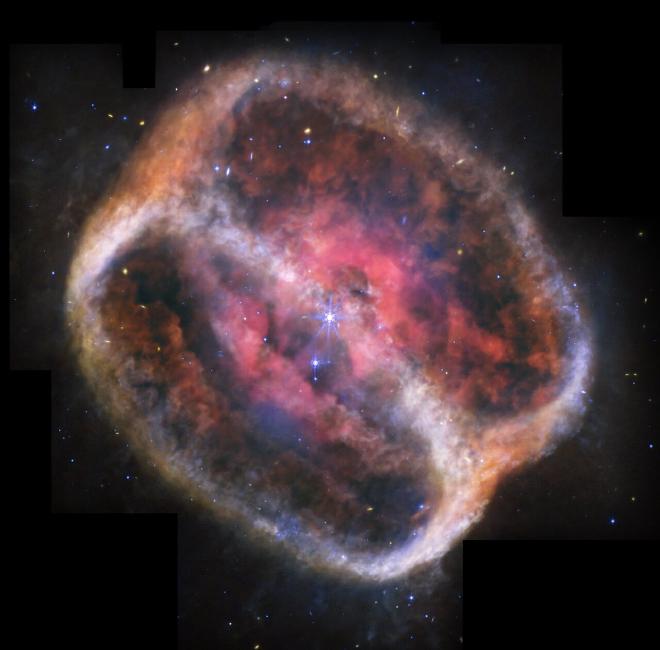

The rings around NGC 1514 were discovered in 2010, but now Webb is allowing scientists to comprehensively examine the turbulent nature of this nebula.
This scene has been forming for at least 4,000 years — and will continue to change over many more millennia. At the center are two stars that appear as one in Webb’s observation, and are set off with brilliant diffraction spikes. The stars follow a tight, elongated nine-year orbit and are draped in an arc of dust represented in orange.
One of these stars, which used to be several times more massive than our Sun, took the lead role in producing this scene. Once the star’s outer layers were exhausted, only its hot, compact core remained. As a white dwarf star, its winds both sped up and weakened, which might have swept up material into thin shells.
Its hourglass shape #
Webb’s observations show the nebula is at a 60-degree angle, which makes it look like a can is being poured, but it’s far more likely that NGC 1514 takes the shape of an hourglass with the ends lopped off. Look for hints of its pinched waist near top left and bottom right, where the dust is orange and drifts into shallow V-shapes. When this star was at its peak of losing material, the companion could have gotten very close, resulting in these unusual shapes. Instead of producing a sphere, this interaction might have instead formed rings.
A network of dappled structures #
The nebula’s two rings are unevenly illuminated in Webb’s observations, appearing more diffuse at bottom left and top right. They also look fuzzy, or textured. Scientists believe the rings are primarily made up of very small dust grains, which, when hit by ultraviolet light from the white dwarf star, heat up enough to be detected by Webb.
NGC 1514 is also notable for what is absent. Carbon and more complex versions of it, smoke-like material known as polycyclic aromatic hydrocarbons, are common in planetary nebulae (expanding shells of glowing gas expelled by stars late in their lives). Neither were detected in NGC 1514. More complex molecules might not have had time to form due to the orbit of the two central stars, which mixed up the ejected material. A simpler composition also means that the light from both stars reaches much farther, which is why we see the faint, cloud-like rings.
This planetary nebula has been studied by astronomers since the late 1700s. Astronomer William Herschel noted in 1790 that NGC 1514 was the first deep sky object to appear genuinely cloudy — he could not resolve what he saw into individual stars within a cluster, like other objects he cataloged. With Webb, our view is considerably clearer.

